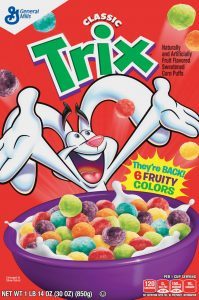Catherine Keyser at Cabinet Magazine:
 In 2015, General Mills reformulated Trix with “natural” colors. Customers complained that the bright hues of their childhood cereal were now dull yellows and purples. Two years later, the company released Classic Trix to stand on store shelves alongside so-called No, No, No Trix, the natural version. This nickname, promising “no tricks,” sounds abstemious; the virtuous customer says no to technicolor temptation. But Trix customers wanted their colors back. As one Tweet put it: “I mean, I get that artificial flavors are bad and all that shiz, but man I miss neon colored Trix.”
In 2015, General Mills reformulated Trix with “natural” colors. Customers complained that the bright hues of their childhood cereal were now dull yellows and purples. Two years later, the company released Classic Trix to stand on store shelves alongside so-called No, No, No Trix, the natural version. This nickname, promising “no tricks,” sounds abstemious; the virtuous customer says no to technicolor temptation. But Trix customers wanted their colors back. As one Tweet put it: “I mean, I get that artificial flavors are bad and all that shiz, but man I miss neon colored Trix.”
What can (or should) the scholar of American culture make of this desire for color? Bright foods are in some sense an invention of a modern food industry that uses dye to intensify visual aesthetics. They also, however, evoke the tropics, brilliant fruits like bananas and oranges that became more broadly available in the United States in the early twentieth century thanks to corporate imperialism and cold storage. Though its colors came from industrial dyes, General Mills hoped to associate Trix with this tropical paradise.
more here.
